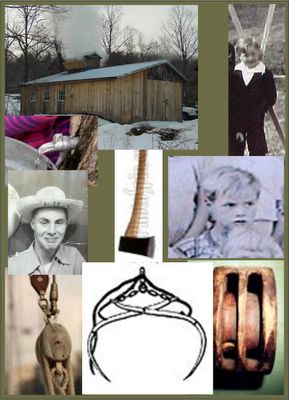
Tapping Trees

Merel Jr. chopped my finger off when I was eight years old
Betty said her parents almost died when they were told
We thought we’d make some maple syrup that day in early spring
We gathered spigots, augers, hammers, pans, & pails to bring
Out to the woods across the road where lots of maples were
With tag alders and large beech trees, White pine and Douglas fir
Folks used to tap a lot of trees out there when we were young
The biggest sugar bush I knew was Bessie Cleveland’s farm
Ernel Briggs would boil the sap o’er smoky crackling fires
To get that wondrous maple syrup to fulfill our desires
For tastes and smells to make our lives a little bit more sweet
We’d drown our eggs and pancakes in it ‘n make ’em “fit to eat”.
So we gathered some old siding for the fire to boil the sap
The other kids took all the tools to find some trees to tap
Merel Jr. had the axe to swing and I would hold the wood
And move my hand before he hit as quickly as I could
About the second chop or so, all things just went to hell
The axe came down on my right hand and blood began to swell
My right hand middle finger tip hung by a slender strip
The bright white bone was shining through as blood began to drip
Merel Jr screamed and horrified, he grabbed me by the arm
And dragged my through the barn yard crick and up behind the barn
My mother, hearing screams, came out an met us on the lawn
Took Wayne’s clean diaper from the line and wrapped my hand & arm
They took me to Doc Persons, a doc in Lexington
A mustached red faced kind old man, much rumpled and rotund
He took that flopping finger tip and stood it up real straight
And with a splint just wrapped it up with white adhesive tape
Two days later we went back to see that plump old doc
To bar lockjaw, each scrawny arm received 8 tetnus shots
That finger used to throb and ache in weather wet or cold
But all of that evolved away as I got grey and old
Lots of kids got hurt back then on farms their families owned
The most dangerous place for a kid back then was the place that they called home
At Mackey’s Corners, Bobby Mace lost a thumb one day
He got it caught in block and tackle used to draw off hay
I remember him one handed shooting fouls from the line
While the rest of us threw underhand, like Mikan at the time
Now all that’s 60 years ago and if you haven't seen it
When I flip you the finger, you can see I really mean it.
Notes From The Internet:
Tree Tapping - Where It All Begins
Did you know that although Europeans knew how to tap trees, it was the American Indian who discovered how to make maple syrup?
Indians from New England to Canada were producing maple syrup from 1664. The Indians made a sloping cut, or gash, two inches deep and 2-1/2 inches long, in the side of a tree. A knife or wood chip was put into the bottom of the cut so the sap flowed down the cut, onto the knife and into a receptacle on the ground.
The receptacles were made either of bark caulked with pitch or hollowed out logs. By 1765, the settlers changed the Indians' tapping to tree boxing. They trimmed off the bark and chopped a 1/2-inch deep square or rectangular hole into the tree trunk. A sloping trough was put into the tree trunk to take the sap from the hole, or box, to a spout or spile, which led the sap from the trough to a receptacle.
Boring holes in a tree started around 1774.By 1950, the present day tapping was accepted. Spiles are used to direct the flow of sap from the trunk. Originally they were wooden, then the Eureka sap spout, made of galvanized cast iron, took over. It was replaced by metal spiles and buckets and also plastic spiles for plastic or polyethylene tubing.
The Indians used a basket or tub from hollowed out tree bark as a collecting receptacle. They were placed on the snow or ground at the base of the tree. Troughs were used by the colonists until the late 1840's.
Wooden buckets or pails were introduced as early as 1748, but weren't common until much later. Wooden buckets were still used in 1935; then they were replaced by tin-plated buckets because the wooden buckets dried out and leaked if they weren't painted every year.
Bucket covers have been used since 1870 to keep leaves and debris out. Plastic tubing, used since 1965, takes sap directly to a gathering vat or storage tank.
No comments:
Post a Comment